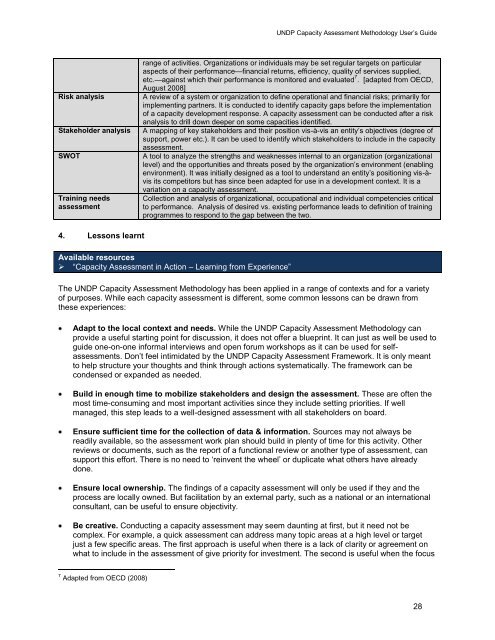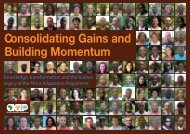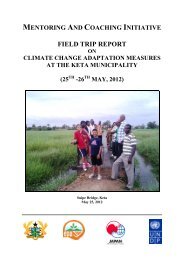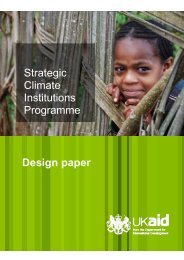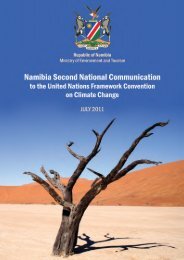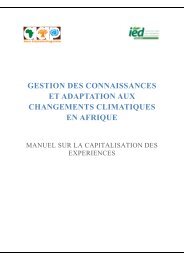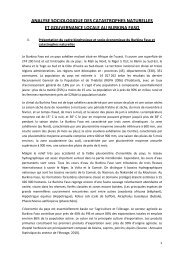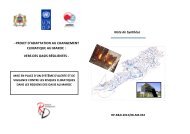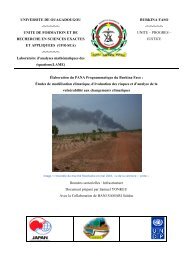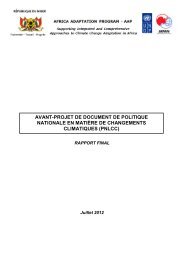UNDP Capacity Assessment Users Guide.pdf - Africa Adaptation ...
UNDP Capacity Assessment Users Guide.pdf - Africa Adaptation ...
UNDP Capacity Assessment Users Guide.pdf - Africa Adaptation ...
Create successful ePaper yourself
Turn your PDF publications into a flip-book with our unique Google optimized e-Paper software.
<strong>UNDP</strong> <strong>Capacity</strong> <strong>Assessment</strong> Methodology User‘s <strong>Guide</strong>Risk analysisStakeholder analysisSWOTTraining needsassessmentrange of activities. Organizations or individuals may be set regular targets on particularaspects of their performance—financial returns, efficiency, quality of services supplied,etc.—against which their performance is monitored and evaluated 7 . [adapted from OECD,August 2008]A review of a system or organization to define operational and financial risks; primarily forimplementing partners. It is conducted to identify capacity gaps before the implementationof a capacity development response. A capacity assessment can be conducted after a riskanalysis to drill down deeper on some capacities identified.A mapping of key stakeholders and their position vis-à-vis an entity‘s objectives (degree ofsupport, power etc.). It can be used to identify which stakeholders to include in the capacityassessment.A tool to analyze the strengths and weaknesses internal to an organization (organizationallevel) and the opportunities and threats posed by the organization‘s environment (enablingenvironment). It was initially designed as a tool to understand an entity‘s positioning vis-àvisits competitors but has since been adapted for use in a development context. It is avariation on a capacity assessment.Collection and analysis of organizational, occupational and individual competencies criticalto performance. Analysis of desired vs. existing performance leads to definition of trainingprogrammes to respond to the gap between the two.4. Lessons learntAvailable resources‣ ―<strong>Capacity</strong> <strong>Assessment</strong> in Action – Learning from Experience‖The <strong>UNDP</strong> <strong>Capacity</strong> <strong>Assessment</strong> Methodology has been applied in a range of contexts and for a varietyof purposes. While each capacity assessment is different, some common lessons can be drawn fromthese experiences:Adapt to the local context and needs. While the <strong>UNDP</strong> <strong>Capacity</strong> <strong>Assessment</strong> Methodology canprovide a useful starting point for discussion, it does not offer a blueprint. It can just as well be used toguide one-on-one informal interviews and open forum workshops as it can be used for selfassessments.Don‘t feel intimidated by the <strong>UNDP</strong> <strong>Capacity</strong> <strong>Assessment</strong> Framework. It is only meantto help structure your thoughts and think through actions systematically. The framework can becondensed or expanded as needed.Build in enough time to mobilize stakeholders and design the assessment. These are often themost time-consuming and most important activities since they include setting priorities. If wellmanaged, this step leads to a well-designed assessment with all stakeholders on board.Ensure sufficient time for the collection of data & information. Sources may not always bereadily available, so the assessment work plan should build in plenty of time for this activity. Otherreviews or documents, such as the report of a functional review or another type of assessment, cansupport this effort. There is no need to ‗reinvent the wheel‘ or duplicate what others have alreadydone.Ensure local ownership. The findings of a capacity assessment will only be used if they and theprocess are locally owned. But facilitation by an external party, such as a national or an internationalconsultant, can be useful to ensure objectivity.Be creative. Conducting a capacity assessment may seem daunting at first, but it need not becomplex. For example, a quick assessment can address many topic areas at a high level or targetjust a few specific areas. The first approach is useful when there is a lack of clarity or agreement onwhat to include in the assessment of give priority for investment. The second is useful when the focus7 Adapted from OECD (2008)28


